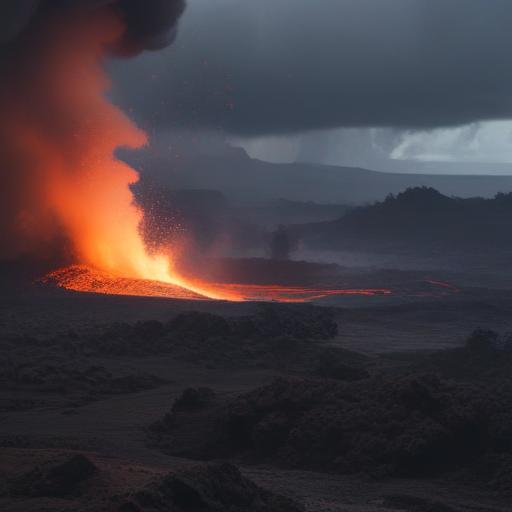Kīlauea Summit Eruption Episode 30 Brings New Fissure, Ground Cracks, and Updated Hazards
Volcano activity at Kīlauea’s summit continues to unfold with Episode 30, which began in the early hours of August 6. Two active vents in the Halemaʻumaʻu crater, the north and south vents in its southwest portion, have been feeding lava fountains and flows onto the crater floor. The episode has shown consistent eruptive behavior, with the two vents sometimes erupting together or alternately and slowly changing their cone shapes over time. Ground deformation has remained a dominant feature: inflation leading into fountaining, followed by pressure release and deflation during the eruption.
Seismic signals have been dominated by tremor, a hallmark of moving magma and gas. Tremor levels have been relatively low between episodes, rising to eruptive tremor as fountaining intensifies. In contrast, true volcano-tectonic earthquakes—brittle-fracture quakes—have been infrequent around the caldera during this eruption, resulting in a lower overall earthquake count.
Episode 30’s onset was unusual. A deflationary tilt was detected at the Uēkahuna Bluff tiltmeter roughly 12:45 a.m. HST, followed by lava appearing in the north vent about ten minutes later and overflowing within a minute. At 1:00 a.m., rapid tilting away from the caldera was recorded by the Sand Hill tiltmeter, accompanied by shallow earthquakes just south of the Halemaʻumaʻu vents. Magma then surfaced in the south vent at 1:07 a.m., and a new fissure opened on the south side of Halemaʻumaʻu, with one of the largest earthquakes occurring at 1:12 a.m. The south vent erupted about a minute later, and vigorous, high-volume fountaining from the north vent began around 1:20 a.m. The Sand Hill tiltmeter then shifted back toward inward tilting, and earthquakes subsided.
A rapid swarm of volcano-tectonic earthquakes and a notable southward tilt of microradians near the Sand Hill site signaled the opening of a subsurface crack. Magma surged within that crack and reached the surface to form a new fissure in less than 12 minutes, erupting for roughly four hours before subside. The new fissure stopped erupting by early afternoon but marks a significant shift in the eruption’s dynamics.
Radar imagery from the period shows persistent ground movement around the new fissure and nearby faulted areas. Ground movement patterns indicated by radar fringes show southwest movement toward the satellite on one side of the fissure and northeast movement on the opposite side. The fragility of the caldera’s rim was underscored by the observation of new cracks extending beyond the fissure toward the crater rim, as well as sinkholes forming in ash-covered ground on the south rim. These observations point to a shallow magma source feeding the fissure, at depths of less than about 1 kilometer.
The implications of Episode 30 are clear: volcanic systems can evolve quickly, producing new hazards even within an eruption that has appeared steady for weeks. In addition to new fissures and ground cracks, unstable cliffs within the caldera could fail without warning. The warning is a reminder to stay clear of the closed area west of Halemaʻumaʻu and to follow all park and authorizing agency guidance.
Activity in context
– Kīlauea has been erupting episodically from the summit caldera since December 23, 2024. The current alert level remains WATCH.
– Episode 30 began August 6, with rapid evolution including the opening of a new fissure, significant ground deformation, and high-volume fountaining for several hours.
– The summit’s sulfur dioxide emissions remain elevated during eruptive episodes.
– Mauna Loa shows no signs of eruption and remains at NORMAL alert status.
– Two felt earthquakes were reported in the past week: a magnitude 3.2 event near Pāhala at a depth of about 30 kilometers, and a magnitude 2.9 event near Honaunau-Napoopoo at a depth of about 8 kilometers.
What to watch next
– Continued monitoring of ground deformation, tremor, and seismic swarms to detect shifts in eruption style or new fissure formation.
– Potential for new cracks, collapses, or rockfalls around Halemaʻumaʻu; ongoing hazards in and near the closed areas.
– Gas emissions and ash activity, if any, and how they may affect air quality in nearby communities and parks.
– Park visitors and residents should stay informed through official advisories and heed safety guidance.
Summary
Episode 30 reinforces the dynamic and evolving nature of Kīlauea’s summit eruption. A new fissure opened rapidly, driven by a shallow magma source, accompanied by ground deformation and a surge in eruptive activity. While the eruption has continued to display a recognizable pattern of inflation and fountaining, the emergence of new cracks and sinkholes highlights the potential for rapid changes and renewed hazards in the surrounding area. The monitoring teams will continue to track these developments closely to keep people safe and informed.
Additional note for readers
Ongoing monitoring and clear communication about hazards remain crucial as the eruption evolves. For those in the area, prioritize safety, follow official guidance, and stay tuned for updates as scientists continue to assess and describe changes in real time.
